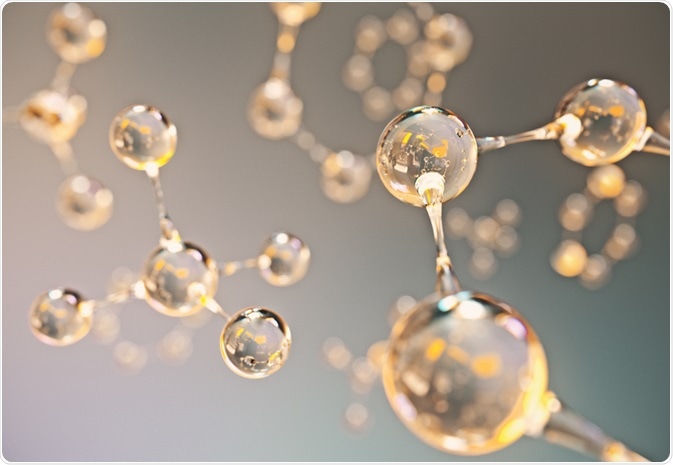High-performance liquid chromatography (HPLC) is a technique used to separate molecules based on size and surface charge, among other properties.
The incorporation of ultra-violet (UV) spectroscopy with HPLC allows the concentration of molecules to be determined following separation.
 Image Credit: Connect World / Shutterstock
Image Credit: Connect World / Shutterstock
High-Performance Liquid Chromatography (HPLC)
HPLC was previously named high-pressure liquid chromatography, distinct from low-pressure liquid chromatography methods, as this method relies on gravity. Pressures of 50 – 350 bar are frequently employed to pass the liquid mobile phase through a column containing the solid stationary phase.
A column containing absorbent material, typically granular silica or polymer, makes up the stationary phase. The mobile phase consists of a pressurized liquid solvent mixture, often water, acetonitrile, and/or methanol. The mobile phase is chosen depending on the sample of interest and composition of the stationary phase.
Molecules within the sample have differing degrees of interaction with the mobile and stationary phases, which determines the degree of separation achievable between them.
Size-exclusion chromatography
Molecules within a sample can be separated by size during HPLC. The stationary phase is made up of porous silica beads, which small molecules can enter, while larger molecules must go around the beads and pass through the spaces between them. This allows larger molecules to elute more quickly than smaller ones, since smaller molecules become stuck within the silica beads for longer periods.
This method is often used in the molecular weight determination of proteins, polysaccharides, or polymers, and can be used to infer the tertiary and quaternary structure of proteins.
Ion-exchange chromatography
Molecules within a sample can also be separated based on their attraction to the stationary phase. A silica stationary phase, for example, has exposed oxygen atoms on its surface that present a negative charge.
Molecules within a sample that bear a negative charge are prevented from binding with the stationary phase, and thus elute more quickly.
The solvent conditions can be changed once non-binding molecules have passed from the column, detaching molecules that have become bound to the stationary phase and allowing them to elute.
This technique is commonly used in water purification, ligand-exchange chromatography, and ion-exchange chromatography.
Normal-phase chromatography
Samples that is readily dissolvable in non-polar, non-aqueous solvents such as chloroform can undergo normal-phase chromatography. A polar stationary phase is used in addition to size-exclusion principles to allow separation of molecules based on these properties.
Steric factors can also play a role in the retention time of a molecule, and so this method is commonly used to separate isomers. For example, molecules with two polar functional groups adjacent to one another will both be able to interact with the stationary phase. This results in a longer retention time than an isomer with its polar groups on opposite sides of the molecule, where the functional groups are unable to interact with the stationary phase simultaneously.
Reversed-phase chromatography
In reversed-phase HPLC, the stationary phase is non-polar, while the liquid mobile phase is the stationary phase surface and is often coated with straight alkyl chains, meaning that polar molecules elute more quickly due to hydrophobic interactions, while hydrophilic molecules have a greater retention time.
Reversed-phase chromatography is the most common form of HPLC, and is often used in the pharmaceutical industry for the purposes of quality control.
Beer-Lambert Law
Illuminating eluted molecules with UV light allows their concentration to be determined.
By taking a known concentration of a molecule and shining UV light on it and measuring the intensity of absorbed and reflected light at specific wavelengths, a baseline can be set to allow for the calculation of any concentration of that molecule using the Beer-Lambert law:
A = εbc
Where A is the absorbance measured by the detector at a specific wavelength, ε is the molar absorptivity of the molecule, b is the path length through the sample, and c is the concentration of the sample.
Combining HPLC and UV spectroscopy allows for a mixture of molecules to be separated and their relative proportions to be determined by calculation of their concentrations following elution from the HPLC column.
Sources:
- What is HPLC/UV?
- Beer-Lambert Law.
- What is HPLC?
Further Reading
- All Chromatography Content
- Chromatography Overview
- Gas Chromatography-Mass Spectrometry (GC-MS) Applications
- High Performance Liquid Chromatography (HPLC)
- Liquid Chromatography-Mass Spectrometry (LC-MS) Applications
Last Updated: Oct 31, 2018

Written by
Michael Greenwood
Michael graduated from Manchester Metropolitan University with a B.Sc. in Chemistry in 2014, where he majored in organic, inorganic, physical and analytical chemistry. He is currently completing a Ph.D. on the design and production of gold nanoparticles able to act as multimodal anticancer agents, being both drug delivery platforms and radiation dose enhancers.
Source: Read Full Article